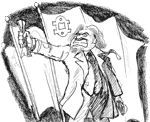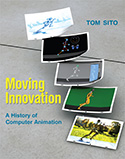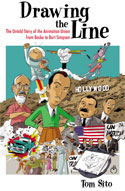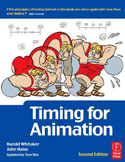“ While most people with a knowledge of animation history will know of the 1941 Disney strike and others may know of the 1937 Fleischer strike, the history of the labour movement in animation has mostly gone unreported. Instead, histories have concentrated on studios, cartoon characters and individual artists. Tom Sito argues, however, that unions have had a significant effect on animation history and he documents it in this groundbreaking book.
Sito is uniquely positioned to record this story. Anyone who knows him (and I have to disclose that I've known Tom for decades and supplied some material for this book) knows that history is his avocation. But more important, he is a 30-year veteran of the animation industry with wide-ranging experience. He's worked in several cities and countries; he's been employed as an animator, story artist and director; and he's served as the president of the Los Angeles animation union.
Sito begins his story with the birth of animation and continues it to the present day, where globalization and technology have both transformed the industry. He documents working conditions and the early, failed attempts to unionize. He shows how animators were part of the larger movement to unionize Hollywood in the 1930s. Besides the strikes mentioned above, he writes about strikes against Leon Schlesinger and Paul Terry.
During the postwar period, the right-wing backlash against the New Deal gave birth to the witch hunt for American communists. The blacklist era, when studios refused to hire anyone with connections to left wing causes, not only affected live-action filmmakers but also artists working in animation.
In the TV era, the Los Angeles union launched two strikes in an attempt to stop work from going overseas.
To his credit, Sito pulls no punches. The book isn't a valentine to the labour movement and an attack on management. He discusses the involvement of organized crime in unions, the intramural conflict between rival animation unions, and the generation, skills and technology gaps that have alienated union members from each other. He also respects managers like Walt Disney, Max Fleischer, Bill Hanna, Joe Barbera and Jeffrey Katzenberg, acknowledging their contributions to the field.
The book is based on research as well as interviews Sito conducted. While the subject of labour history may sound dry, Sito has an engaging writing style and has personalized the history by telling stories of individual artists.
Illustrations include photos and drawings that show artists at work and on picket lines. It's a shame that the illustrations couldn't be printed larger. It would take an electron microscope to identify some of the people in the photos.
While this book fills important gaps in the historical record, it isn't perfect. Sito sometimes makes errors or imprecise statements. For example, Mr. Deeds Goes to Town was produced by Columbia, not Paramount. Chilly Willy was a Lantz character, not MGM. IDT had nothing to do with the recent feature Hoodwinked. Pete Docter's name is misspelled, as is Ed Catmull's. Sito claims that Ward Kimball and Walt Kelly were no longer close after the Disney strike, but Kelly contributed an illustration and liner notes to one of Kimball's record albums with the Firehouse Five as well as writing the introduction to Kimball's book Art Afterpieces. Sito also claims that Paul Terry never allowed screen credit for anyone but himself, but he regularly credited writers, directors and his musical director, though his animators did remain anonymous.
These gaffes are regrettable, but don't detract from the book's importance. Sito has provided fans of animation history with a new perspective on events. Those working in the industry will learn why conditions are as they are and students hoping to enter the field will understand the choices they will one day confront. Drawing the Line is a major addition to our understanding of animation history and an honest look at how animation artists have struggled for recognition and compensation.”
Sito is uniquely positioned to record this story. Anyone who knows him (and I have to disclose that I've known Tom for decades and supplied some material for this book) knows that history is his avocation. But more important, he is a 30-year veteran of the animation industry with wide-ranging experience. He's worked in several cities and countries; he's been employed as an animator, story artist and director; and he's served as the president of the Los Angeles animation union.
Sito begins his story with the birth of animation and continues it to the present day, where globalization and technology have both transformed the industry. He documents working conditions and the early, failed attempts to unionize. He shows how animators were part of the larger movement to unionize Hollywood in the 1930s. Besides the strikes mentioned above, he writes about strikes against Leon Schlesinger and Paul Terry.
During the postwar period, the right-wing backlash against the New Deal gave birth to the witch hunt for American communists. The blacklist era, when studios refused to hire anyone with connections to left wing causes, not only affected live-action filmmakers but also artists working in animation.
In the TV era, the Los Angeles union launched two strikes in an attempt to stop work from going overseas.
To his credit, Sito pulls no punches. The book isn't a valentine to the labour movement and an attack on management. He discusses the involvement of organized crime in unions, the intramural conflict between rival animation unions, and the generation, skills and technology gaps that have alienated union members from each other. He also respects managers like Walt Disney, Max Fleischer, Bill Hanna, Joe Barbera and Jeffrey Katzenberg, acknowledging their contributions to the field.
The book is based on research as well as interviews Sito conducted. While the subject of labour history may sound dry, Sito has an engaging writing style and has personalized the history by telling stories of individual artists.
Illustrations include photos and drawings that show artists at work and on picket lines. It's a shame that the illustrations couldn't be printed larger. It would take an electron microscope to identify some of the people in the photos.
While this book fills important gaps in the historical record, it isn't perfect. Sito sometimes makes errors or imprecise statements. For example, Mr. Deeds Goes to Town was produced by Columbia, not Paramount. Chilly Willy was a Lantz character, not MGM. IDT had nothing to do with the recent feature Hoodwinked. Pete Docter's name is misspelled, as is Ed Catmull's. Sito claims that Ward Kimball and Walt Kelly were no longer close after the Disney strike, but Kelly contributed an illustration and liner notes to one of Kimball's record albums with the Firehouse Five as well as writing the introduction to Kimball's book Art Afterpieces. Sito also claims that Paul Terry never allowed screen credit for anyone but himself, but he regularly credited writers, directors and his musical director, though his animators did remain anonymous.
These gaffes are regrettable, but don't detract from the book's importance. Sito has provided fans of animation history with a new perspective on events. Those working in the industry will learn why conditions are as they are and students hoping to enter the field will understand the choices they will one day confront. Drawing the Line is a major addition to our understanding of animation history and an honest look at how animation artists have struggled for recognition and compensation.”
-- Mark Mayerson
_______________




